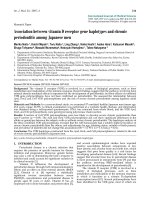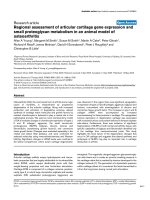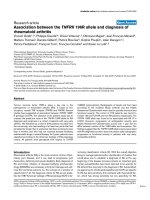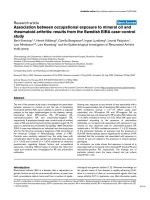Báo cáo y học: "Association between vitamin D receptor gene haplotypes and chronic periodontitis among Japanese men" doc
Bạn đang xem bản rút gọn của tài liệu. Xem và tải ngay bản đầy đủ của tài liệu tại đây (470.59 KB, 7 trang )
Int. J. Med. Sci. 2007, 4
216
International Journal of Medical Sciences
ISSN 1449-1907 www.medsci.org 2007 4(4):216-222
©Ivyspring International Publisher. All rights reserved
Research Paper
Association between vitamin D receptor gene haplotypes and chronic
periodontitis among Japanese men
Mariko Naito
1
, Koichi Miyaki
2
, Toru Naito
3
, Ling Zhang
4
, Keika Hoshi
5
, Asako Hara
6
, Katsunori Masaki
6
,
Shugo Tohyama
6
, Masaaki Muramatsu
4
, Nobuyuki Hamajima
1
, Takeo Nakayama
2
1. Department of Preventive Medicine/Biostatistics and Medical Decision Making, Nagoya University Graduate School of
Medicine, 65 Tsurumai-cho, Showa-ku, Nagoya, 466-8550, Japan
2. Department of Health Informatics, Kyoto University School of Public Health, Yoshida konoe-cho, Sakyo-ku, Kyoto,
606-8501, Japan
3. Department of General Dentistry, Fukuoka Dental College, 2-15-1 Tamura, Sawara-ku, Fukuoka, 814-0193, Japan
4. Department of Molecular Epidemiology, Medical Research Institute, Tokyo Medical and Dental University, 2-3-10
Kandasurugadai, Chiyoda-ku, Tokyo, 101-0062, Japan
5. Information Design Section, Center for Information Research and Library, National Institute of Public Health, 2-3-6
Minami, Wako, Saitama, 351-0197, Japan
6. Keio University Hospital, 35 Shinanomachi, Shinjuku-ku, Tokyo, 160-8582, Japan
Correspondence to: Mariko Naito, Tel: +81-52-744-2132, Fax: +81-52-744-2971, E-mail:
Received: 2007.06.30; Accepted: 2007.08.20; Published: 2007.08.22
Background: The vitamin D receptor (VDR) is involved in a variety of biological processes, such as bone
metabolism and modulation of the immune response. Recent findings suggest that the pathway involving bone
mineral density-mediated effects is important for the development of periodontitis, but their effects of combined
VDR gene polymorphisms have not been confirmed on periodontitis. We assessed the relationship between
ApaI, BsmI, and FokI VDR polymorphisms and the risk of severe chronic periodontitis among Japanese adult
men.
Materials and Methods: In a cross-sectional study, we examined 97 unrelated healthy Japanese men (mean age:
45.6 years, range: 22-59). A clinical examination was performed at a worksite health checkup, and information
was obtained using a self-reported questionnaire. DNA was extracted from whole blood, and the VDR ApaI,
BsmI, and FokI polymorphisms were genotyped using polymerase chain reaction.
Results: F-carriers of FokI VDR polymorphisms were less likely to develop severe chronic periodontitis than
non-F-carriers (p = 0.09). The ApaI and BsmI VDR polymorphisms did not show significant differences in the
alleles or genotypes between the subjects with or without severe chronic periodontitis. The haplotype analysis of
the three combined VDR polymorphisms revealed that the Abf homozygote had a notably higher prevalence of
severe chronic periodontitis than the others, and adjustments for age, smoking status, number of teeth present,
and prevalence of diabetes did not change this association (OR = 7.5; 95% CI = 1.6-34.4; p = 0.01).
Conclusion: The VDR haplotype constructed from the ApaI, BsmI, and FokI polymorphisms is related to the risk
of severe chronic periodontitis in Japanese men.
Key words: chronic periodontitis; vitamin D receptor; polymorphism; haplotypes
1. INTRODUCTION
Periodontal disease is a chronic infection that
requires the presence of specific bacteria for disease
initiation and progression. Moreover, genetic factors
may play a role in determining the host’s response to
infection and could account for significant variation in
its clinical severity [1].
Vitamin D influences the development of
periodontal disease through both immunomodulatory
effects and an effect on bone mineral density (BMD)
[2,3]. Dietrich et al. [4] reported a statistically
significant inverse association between serum
25(OH)D
3
concentrations and periodontal disease in
people aged 50 years or older. Vitamin D has an
important role in bone formation and preservation [5],
and several epidemiological studies have reported
positive associations between osteoporosis or low
bone density and alveolar bone and tooth loss, which
suggests that poor bone quality is a risk factor for
developing periodontal disease [6-8]. Recent findings
suggest that alveolar bone loss in periodontal disease
is more pronounced in osteoporotic bone [9] and that
the pathway involving BMD-mediated effects is
important for the development of periodontitis [4].
The vitamin D receptor (VDR) is involved in a
variety of biological processes, such as bone
metabolism and modulation of the immune response,
in which it functions as a vitamin D
3
-dependent
transcription factor [10]. Several polymorphisms have
been identified in the VDR gene, most of which are
Int. J. Med. Sci. 2007, 4
217
identified by biallelic variation in restriction enzyme
sites. Examples of restriction fragment length
polymorphisms (RFLPs) in the VDR gene include
Tru9I [11], TaqI [12], BsmI [13], EcoRV [13], ApaI [14],
and FokI [15,16]. All these RFLPs, except FokI in exon 2,
are located between exons 8 and 9. By using the
sequencing technique, new polymorphisms such as
Cdx2 [17] in the promoter region have also been
detected.
Morrison et al. [12] found an association between
bone mass and polymorphisms of the recognition sites
of the restriction enzymes BsmI and ApaI in the 3'-end
of the VDR gene, and in addition to the effect on
mineral metabolism, several studies have investigated
the relationship between the VDR polymorphisms and
diseases. The effect of VDR polymorphisms in renal
failure has been explored, and Sezer et al.
demonstrated that the BsmI polymorphism was
related to the decreased recombinant human
erythropoietin requirements needed to achieve higher
hemoglobin levels among dialysis patients [18].
Associations between VDR polymorphisms and
susceptibility and outcome have been indicated in
prostate, lung, and colon cancers [19-21]. Zou et al. [20]
suggested that VDR polymorphisms of Cdx2, FokI, and
BsmI were associated with improved survival among
squamous cell carcinoma patients with early-stage
non-small-cell lung cancer. Furthermore,
nephrolithiasis has been suggested as being related to
the VDR FokI polymorphism [22].
Some association studies involving the VDR,
mostly the TaqI polymorphism and periodontal
disease, have been conducted in different ethnic
populations and settings [23,24], and a few studies
have investigated the effect of VDR ApaI, BsmI, or FokI
polymorphism on periodontitis. According these
results, the A allele for ApaI and the f allele for FokI
might be correlated with an increased risk of
periodontitis [25,26]. However, none has confirmed
the association between the VDR polymorphism and
the risk of periodontal disease. Moreover, few studies
have examined their effects on periodontitis, although
the effects of combined VDR gene polymorphisms on
BMD have been reported [27-29].
Therefore, we examined the relationship between
ApaI, BsmI, and FokI VDR polymorphisms and the
risk of severe chronic periodontitis among Japanese
adult men. A strong association between smoking and
periodontal disease has been revealed in several
previous studies [30-32]. In Japan, the smoking rate in
males is the highest among industrialized countries,
while the prevalence in females remains low [33]. We
hypothesized that VDR polymorphisms would be
associated with periodontal disease as an independent
risk factor in spite of smoking. We focused on male
subjects
in this study.
2. MATERIALS AND METHODS
Participants
The subjects were employees in a Japanese
chemical company. This report is a part of a
cross-sectional study that was previously reported
[34]. A total of 291 male subjects participated. Of these,
97 subjects who gave informed consent for DNA
analysis were analyzed. The participants were
recruited and examined between September and
October 2004. All volunteers signed written consent
forms before participating.
The study comprised 97 healthy Japanese males
between 22 and 59 years of age (mean age: 45.6 years).
A dental examination was conducted as a worksite
health checkup. Venous blood samples were obtained
before the examination, and weight and height were
measured in all subjects. The body mass index (BMI)
was computed by dividing the body weight in
kilograms by the square of the height in meters. The
mean (±SD) BMI was 23.3 ± 3.1 kg/m
2
, which is
typical for healthy Japanese males. Information on
smoking status was obtained using a self-reported
questionnaire. Smoking status was assessed and
subjects were classified as a “current smoker” or “not
a current smoker.” A diagnosis of diabetes was made
according to the Japan Diabetes Society criteria based
on a fasting plasma glucose ≥126 mg/dl and HbA1c
≥6.5%.
Each participant was examined by either of two
qualified dentists (K.H. and M.N.), who carried out
the dental examinations throughout the study period.
The diagnosis of periodontal disease and classification
of its severity were established based on the clinical
parameters of the Community Periodontal Index
(CPI). The two dentists were assigned to subjects at
random. Inter-examiner agreement of CPIs between
the dentists was tested for seven volunteers before the
dental examinations (kappa statistics = 0.77, p = 0.03).
For CPI assessment, 3, 8, 14, 19, 24, and 30 were
measured. Each sextant was designed as either
healthy (score 0); bleeding, but no dental calculus
detected (score 1); calculus detected, but no pockets
(score 2); a probing depth exceeding 4 mm (score 3); or
a probing depth exceeding 6 mm (score 4), according
to the highest score recorded at the index teeth. The
highest score was recorded as the CPI score of the
participant. Severe chronic periodontitis was defined
as oral health status with a CPI of 4. Oral health status
with CPIs between 0 and 3 was classified as having no
severe chronic periodontitis.
Approval for this study was obtained from the
ethics committee of Keio University School of
Medicine, Tokyo, Japan.
Genotype determination
DNA was extracted from whole blood using the
phenol/chloroform method. The VDR polymorphism
was genotyped using polymerase chain reaction (PCR)
followed by melt curve analysis [35] with a
LightTyper instrument (Roche Diagnostics, Penzberg,
Germany). The primers and probes used for
determining the ApaI, BsmI, and FokI single nucleotide
polymorphisms (SNPs) in the VDR genes are listed in
Table 1. According to the dbSNP for FokI SNPs,
rs10735810 was used in this study.
Int. J. Med. Sci. 2007, 4
218
Table 1. Primer and probe sequences for the three polymorphisms of the VDR gene
VDR, vitamin D receptor; SNP, single-nucleotide polymorphism
PCR was performed with 0.5 μM sense primer
and 0.05 μM antisense primer in a reaction mixture
containing 0.2 μM anchor probe, 0.2 μM sensor probe,
10 ng dried DNA, 4.0 μM MgCl
2
, 0.5 μl 10× PCR
buffer, 0.2 mM dNTP, and 0.5 U of Faststart DNA
polymerase (Roche Diagnostics) in a total volume of 5
μl. The cycling program consisted of an initial
denaturation for 10 min at 94°C, 40 cycles of 15 s at
94°C, 55°C for 15 s, and 72°C for 15 s, followed by a
final extension for 2 min at 72°C.
After PCR, the reaction products were denatured
at 94°C for 60 s, annealed at 40°C for 60 s, and melted
by heating from 40 to 80°C at a rate of 0.1°C/s. The
melt curve data were collected and classified using the
LightTyper genotyping software, and genotypes were
determined. The absence or presence of the ApaI,
BsmI, and FokI sites were designated as A, B, and F
alleles and a, b, and f alleles, respectively.
Statistical analysis
The frequency of each of the three
polymorphisms was tested against Hardy-Weinberg
equilibrium using the χ
2
test, which was also used to
compare categorical variables. Differences in the
anthropometric characteristics of the different VDR
genotypes or haplotypes were compared using
one-way analysis of variance. To calculate the odds
ratios (ORs) and 95% confidence intervals (CIs),
multiple logistic regression analysis was performed to
quantify the association between severe chronic
periodontitis and the VDR polymorphisms after
adjusting for age, smoking status , number of teeth
present, and prevalence of diabetes.
A value of p < 0.05 was considered statistically
significant for all analyses. All statistical analyses were
performed using the Statistical Package for the Social
Sciences Version 11 for Windows (SPSS Inc., Chicago,
IL).
3. RESULTS
Single nucleotide polymorphisms
Table 2 shows the demographic features of the
participants with the polymorphisms. The genotype
frequency of each of the VDR ApaI, BsmI, and FokI
polymorphisms was consistent with Hardy-Weinberg
equilibrium. The most frequent genotypes of the ApaI,
BsmI, or FokI polymorphisms were AA, bb, and Ff,
respectively. No one had the BB genotype of the BsmI
polymorphism. No statistically significant differences
were detected in age, BMI, the percentage of current
smokers, the percentage of individuals suffering from
diabetes, or clinical indicators for oral status and the
three genotypes. The study subjects included 42
current smokers (43.3%) and 2 diabetics (2.1%).
The distribution of the CPI scores between 0 and
4 were 13.4, 15.5, 14.4, 39.2, and 17.5%, respectively.
Seventeen subjects were diagnosed with severe
chronic periodontitis. While the mean (±SD)
percentage of teeth with bleeding on probing and the
mean (±SD) probing depth were 72.6 ± 29.3% and
4.0 ± 0.8 mm, respectively, among subjects with
severe chronic periodontitis, those figures were 37.2
± 32.5% and 2.6 ± 0.6 mm among subjects without
severe chronic periodontitis. No statistically
significant differences were found in the mean (±SD)
number of teeth present between subjects with and
without severe chronic periodontitis (25.7 ± 2.1 and
25.3 ± 4.4, respectively).
The FokI genotype and allele frequencies differed
between the groups with and without severe chronic
periodontitis (Table 3). Individuals with any genotype
that contained the F allele were less likely to develop
severe chronic periodontitis than those with the ff
genotype (p = 0.09). Furthermore, heterozygous Ff
individuals had a lower risk of severe chronic
Int. J. Med. Sci. 2007, 4
219
periodontitis than individuals who lacked the F allele
(OR = 0.25; 95% CI = 0.06-0.95). The ApaI and BsmI
polymorphisms did not show statistically significant
differences in alleles or genotypes between the groups
with or without severe chronic periodontitis.
Combined polymorphisms
Seven different haplotypes were identified after
analyzing combinations of the genotype frequencies
for the three VDR polymorphisms: Abf (39.2%), AbF
(28.4%), abF (13.4%), abf (9.3%), aBf (6.7%), Abf (2.6%),
and aBF (0.5%) (Table 4). These haplotypes combined
to form 16 different genotypes, of which the most
prevalent were AAbbFf (20.6%), AAbbff (13.4%),
AAbbFF (12.4%), AabbFf (11.3%), and Aabbff (10.3%).
The Abf haplotype was more common in individuals
with severe chronic periodontitis than in those who
did not have the disease. Moreover, the abF haplotype
was less prevalent in individuals with severe chronic
periodontitis than in those without severe chronic
periodontitis.
Table 5 shows the association between
individuals who were carrying combined VDR
polymorphisms and the prevalence of severe chronic
periodontitis. For this purpose, the data obtained from
participants possessing the most common haplotypes
(Abf, AbF, and abF) were analyzed. The Abf
homozygous individuals had a significantly higher
prevalence of severe chronic periodontitis than the
others, and adjustments for age, smoking status,
number of teeth present, and prevalence of diabetes
did not change this association (OR = 7.5; 95% CI =
1.6-34.4; p = 0.01). After adjusting for age or for all
covariates, the AbF homozygote had a higher
prevalence of severe chronic periodontitis than the
others, and the abF haplotype had a lower prevalence
of severe chronic periodontitis. However, the
differences among the groups were not statistically
significant.
Table 2. Characteristics of the study subjects according to the genotypes of the Apa I, Bsm I, and Fok I VDR polymorphisms
VDR, vitamin D receptor; SD, standard deviation
Table 3. Genotype and allele frequencies of Apa I, Bsm I, and Fok I VDR polymorphisms in subjects with and without severe chronic
periodontitis
† Adjusted for age
‡ χ
2
analysis (a carrier, B carrier, or F carrier versus each reference)
VDR, vitamin D receptor; SNP, single-nucleotide polymorphism; OR, odds ratio; CI, confidence Interval
Int. J. Med. Sci. 2007, 4
220
Table 4. Haplotype and genotype frequencies of the Apa I, BsmI, and Fok I VDR polymorphisms
VDR, vitamin D receptor
Table 5. Associations between the combined Apa I, Bsm I, and Fok I VDR polymorphisms and severe chronic periodontitis risk
† Adjusted for age
† † Adjusted for age, smoking status, number of teeth present, and prevalence of diabetes
VDR, vitamin D receptor; OR, odds ratio; CI, confidence interval
4. DISCUSSION
We examined the relationship between ApaI,
BsmI, and FokI VDR polymorphisms and severe
chronic periodontitis in Japanese males. We
determined that haplotypes of these three
polymorphisms were related to the prevalence of
severe chronic periodontitis, while no statistically
significant associations were found in the analysis of
Int. J. Med. Sci. 2007, 4
221
individual polymorphisms. A single case-control
study has been conducted [25], which revealed that
the VDR haplotype constructed from the TaqI, BsmI,
and FokI VDR polymorphisms was correlated with an
increased risk of periodontitis. To our knowledge, this
is the first study to examine the association between
periodontitis and haplotypes of the ApaI, BsmI, and
FokI VDR polymorphisms.
Two previous studies on BsmI VDR
polymorphisms conducted among Japanese [36] and
Brazilian populations [37] found no statistically
significant differences in the distribution of the BsmI
VDR polymorphism between individuals with and
without periodontal disease. Our data support those
findings. Inagaki et al. [26] demonstrated an
association between the ApaI VDR polymorphism and
the progress of periodontal disease in adult men who
participated in the Dental Longitudinal Study in the
United States. Specifically, they reported that the loss
of alveolar bone and clinical attachment occurred at
the highest rate in the AA genotype of the ApaI VDR
polymorphism compared to the Aa or aa genotypes.
We found that the AA genotype was more likely to
increase the risk of severe chronic periodontitis,
although the differences among the genotypes were
not statistically significant.
Park et al. [25] indicated an association between
the FokI VDR polymorphism and an increased risk of
developing generalized aggressive periodontitis,
whereas Tachi et al. [38] did not find such an
association. Among the haplotypes of the three
polymorphic sites, the Abf homozygote showed that a
VDR allele positively affected the prevalence of severe
chronic disease. The ff genotype of the FokI VDR
polymorphism has been reported to convey stronger
bone resorption and inflammation signals [25]. In our
study, the F allele of the FokI VDR polymorphism was
less likely to increase the risk of severe chronic
periodontitis. This may support the proposal of Park
et al. [25] that the FokI VDR polymorphism plays an
important role in increasing the risk of developing
periodontitis.
Our findings suggest an important possibility
when interpreting studies on the prevention of
periodontitis for a parameter that generally has not
been considered. In a series aimed at describing the
clinical and microbial features over time in
periodontal healthy adult subjects who received
primary prevention, Bogren et al. [39] reported that the
overall changes in clinical parameters were limited
during a 3-year controlled trial with primary
prevention for periodontitis. Although this study had
limitations, such as a small sample size and
cross-sectional study design, the data suggest that the
combined VDR polymorphisms can predict
periodontitis. Analyzing the combined VDR
polymorphisms has the potential to guide
individualized prevention and therapy; thus, further
studies for confirmation are needed.
Accumulated evidence indicates that diabetes is a
major risk factor for periodontitis, and severe
periodontitis often coexists with diabetes [40]. Taylor
et al. [41] concluded that diabetics have a three- to
fourfold increased risk of periodontitis. In addition,
smoking has been established as the most important
environmental risk factor fo
r periodontitis [30], and
cigarette smoking is a strong predictor of progressive
periodontitis [31,32]. Cesar-Neto et al. [42]
demonstrated that smoking modulated gene
expression of cytokines in the periodontium, such as
interleukin (IL)-6 and IL-10. The association between
the Abf haplotype and periodontal disease that we
observed was independent of current smoking status
and the prevalence of diabetes as a statistical
adjustment did not diminish the influence of the VDR
haplotype on periodontal disease status. In fact,
adjusting for those factors did not weaken this
association.
While we report a relationship between the VDR
haplotype and periodontal disease, it remains unclear
whether this association is valid among females,
non-Asians, or people aged 60 years or more. Studies
with larger sample size are also necessary for further
discussion. When only the individual polymorphisms
were analyzed and the haplotypes were not
considered, these effects were not noticed [10].
Clearly, additional studies are needed to determine
whether the combined VDR polymorphisms influence
the risk of developing periodontitis under various
settings.
In conclusion, the VDR haplotype constructed
from the ApaI, BsmI, and FokI VDR polymorphisms is
related to the prevalence of severe chronic
periodontitis in Japanese men. Analysis of VDR
haplotype alleles may be useful for predicting the risk
of developing periodontal disease. Further studies in
gender-, ethnic-, or age-specific groups are needed.
CONFLICTS OF INTEREST
The authors declare that no conflict of interest
exists.
REFERENCES
1. Michalowicz BS, Aeppli D, Virag JG, et al. Periodontal findings
in adult twins. J Periodontol. 1991; 62: 293-299.
2. D'Ambrosio D, Cippitelli M, Cocciolo MG, et al. Inhibition of
IL-12 production by 1,25-dihydroxyvitamin D3. Involvement of
NF-kappaB downregulation in transcriptional repression of the
p40 gene. J Clin Invest. 1998; 101: 252-262.
3. Krall EA, Wehler C, Garcia RI, et al. Calcium and vitamin D
supplements reduce tooth loss in the elderly. Am J Med. 2001;
111: 452-456.
4. Dietrich T, Joshipura KJ, Dawson-Hughes B, et al. Association
between serum concentrations of 25-hydroxyvitamin D3 and
periodontal disease in the US population. Am J Clin Nutr. 2004;
80: 108-113.
5. Specker BL, Ho ML, Oestreich A, et al. Prospective study of
vitamin D supplementation and rickets in China. J Pediatr. 1992;
120: 733-739.
6. Payne JB, Reinhardt RA, Nummikoski PV, et al. Longitudinal
alveolar bone loss in postmenopausal osteoporotic/osteopenic
women. Osteoporos Int. 1999; 10: 34-40.
7. Tezal M, Wactawski-Wende J, Grossi SG, et al. The relationship
between bone mineral density and periodontitis in
postmenopausal women. J Periodontol. 2000; 71: 1492-1498.
Int. J. Med. Sci. 2007, 4
222
8. Dervis E. Oral implications of osteoporosis. Oral Surg Oral Med
Oral Pathol Oral Radiol Endod. 2005; 100: 349-356.
9. Wactawski-Wende J. Periodontal diseases and osteoporosis:
association and mechanisms. Ann Periodontol. 2001; 6: 197-208.
10. Uitterlinden AG, Fang Y, Van Meurs JB, et al. Genetics and
biology of vitamin D receptor polymorphisms. Gene. 2004; 338:
143-156.
11. Ye WZ, Reis AF, Velho G. Identification of a novel Tru9 I
polymorphism in the human vitamin D receptor gene. J Hum
Genet. 2000; 45: 56-57.
12. Morrison NA, Qi JC, Tokita A, et al. Prediction of bone density
from vitamin D receptor alleles. Nature. 1994; 367: 284-287.
13. Morrison NA, Yeoman R, Kelly PJ, et al. Contribution of
trans-acting factor alleles to normal physiological variability:
vitamin D receptor gene polymorphism and circulating
osteocalcin. Proc Natl Acad Sci USA. 1992; 89: 6665-6669.
14. Faraco JH, Morrison NA, Baker A, et al. ApaI dimorphism at the
human vitamin D receptor gene locus. Nucleic Acids Res. 1989;
17: 2150.
15. Gross C, Eccleshall TR, Malloy PJ, et al. The presence of a
polymorphism at the translation initiation site of the vitamin D
receptor gene is associated with low bone mineral density in
postmenopausal Mexican-American women. J Bone Miner Res.
1996; 11: 1850-1855.
16. Saijo T, Ito M, Takeda E, et al. A unique mutation in the vitamin
D receptor gene in three Japanese patients with vitamin
D-dependent rickets type II: utility of single-strand
conformation polymorphism analysis for heterozygous carrier
detection. Am J Hum Genet. 1991; 49: 668-673.
17. Arai H, Miyamoto KI, Yoshida M, et al. The polymorphism in
the caudal-related homeodomain protein Cdx-2 binding
element in the human vitamin D receptor gene. J Bone Miner
Res. 2001; 16: 1256-1264.
18. Sezer S, Tutal E, Bilgic A, et al. Possible influence of vitamin D
receptor gene polymorphisms on recombinant human
erythropoietin requirements in dialysis patients. Transplant
Proc. 2007; 39: 40-44.
19. Moon S, Holley S, Bodiwala D, et al. Associations between
G/A1229, A/G3944, T/C30875, C/T48200 and C/T65013
genotypes and haplotypes in the vitamin D receptor gene,
ultraviolet radiation and susceptibility to prostate cancer. Ann
Hum Genet. 2006; 70: 226-236.
20. Zhou W, Heist RS, Liu G, et al. Polymorphisms of vitamin D
receptor and survival in early-stage non-small cell lung cancer
patients. Cancer Epidemiol Biomarkers Prev. 2006; 15:
2239-2245.
21. Murtaugh MA, Sweeney C, Ma KN, et al. Vitamin D receptor
gene polymorphisms, dietary promotion of insulin resistance,
and colon and rectal cancer. Nutr Cancer. 2006; 55: 35-43.
22. Bid HK, Kumar A, Kapoor R, et al. Association of vitamin D
receptor-gene (FokI) polymorphism with calcium oxalate
nephrolithiasis. J Endourol. 2005; 19: 111-115.
23. Sun JL, Meng HX, Cao CF, et al. Relationship between vitamin
D receptor gene polymorphism and periodontitis. J Periodontal
Res. 2002; 37: 263-267.
24. Brett PM, Zygogianni P, Griffiths GS, et al. Functional gene
polymorphisms in aggressive and chronic periodontitis. J Dent
Res. 2005; 84: 1149-1153.
25. Park KS, Nam JH, Choi J. The short vitamin D receptor is
associated with increased risk for generalized aggressive
periodontitis. J Clin Periodontol. 2006; 33: 524-528.
26. In
agaki K, Krall EA, Fleet JC, et al. Vitamin D receptor alleles,
periodontal disease progression, and tooth loss in the VA dental
longitudinal study. J Periodontol. 2003; 74: 161-167.
27. Jaramillo-Rangel G, Cerda-Flores RM, Cardenas-Ibarra L, et al.
Vitamin D receptor polymorphisms and bone mineral density in
Mexican women without osteoporosis. Am J Hum Biol. 1999; 11:
793-797.
28. Kim JG, Kwon JH, Kim SH, et al. Association between vitamin
D receptor gene haplotypes and bone mass in postmenopausal
Korean women. Am J Obstet Gynecol. 2003; 189: 1234-1240.
29. Macdonald HM, McGuigan FE, Stewart A, et al. Large-scale
population-based study shows no evidence of association
between common polymorphism of the VDR gene and BMD in
British women. J Bone Miner Res. 2006; 21: 151-162.
30. Borrell LN, Papapanou PN. Analytical epidemiology of
periodontitis. J Clin Periodontol. 2005; 32: 132-158.
31. Heitz-Mayfield LJ. Disease progression: identification of
high-risk groups and individuals for periodontitis. J Clin
Periodontol. 2005; 32: 196-209.
32. Razali M, Palmer RM, Coward P, et al. A retrospective study of
periodontal disease severity in smokers and non-smokers. Br
Dent J. 2005; 198: 495-498.
33. Hanioka T, Ojima M, Tanaka K, et al. Association of total tooth
loss with smoking, drinking alcohol and nutrition in elderly
Japanese: analysis of national database. Gerodontology. 2007;
24: 87-92.
34. Miyaki K, Masaki K, Naito M, et al. Periodontal disease and
atherosclerosis from the viewpoint of the relationship between
community periodontal index of treatment needs and
brachial-ankle pulse wave velocity. BMC Public Health. 2006;
6: 131.
35. Bennett CD, Campbell MN, Cook CJ, et al. The LightTyper:
high-throughput genotyping using fluorescent melting curve
analysis. Biotechniques. 2003; 34: 1288-1292.
36. Yoshihara A, Sugita N, Yamamoto K, et al. Analysis of vitamin
D and Fcgamma receptor polymorphisms in Japanese patients
with generalized early-onset periodontitis. J Dent Res. 2001; 80:
2051-2054.
37. de Brito Junior RB, Scarel-Caminaga RM, Trevilatto PC, et al.
Polymorphisms in the vitamin D receptor gene are associated
with periodontal disease. J Periodontol. 2004; 75: 1090-1095.
38. Tachi Y, Shimpuku H, Nosaka Y, et al. Vitamin D receptor gene
polymorphism is associated with chronic periodontitis. Life Sci.
2003; 73: 3313-3321.
39. Bogren A, Teles R, Torresyap G, et al. A three-year prospective
study of adult subjects with gingivitis. I: clinical periodontal
parameters. J Clin Periodontol. 2007; 34: 1-6.
40. Löe H. Periodontal disease. The sixth complication of diabetes
mellitus. Diabetes Care. 1993; 16: 329-334.
41. Taylor GW, Burt BA, Becker MP, et al. Non-insulin dependent
diabetes mellitus and alveolar bone loss progression over 2
years. J Periodontol. 1998; 69: 76-83.
42. Cesar-Neto JB, Duarte P M, de Oliveira MC, et al. Smoking
modulates
int
erleukin-6:interleukin-10 and RANKL:
osteoprotegerin ratios in the periodontal tissues. J Periodontal
Res. 2007; 42: 184-191.









